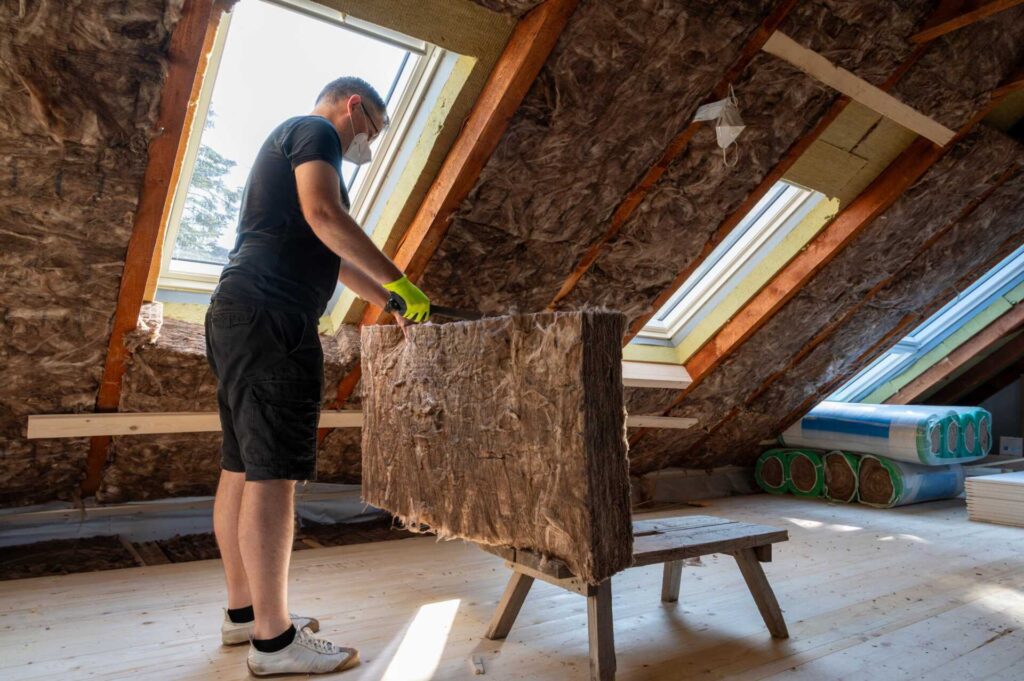
Contents
When you’re considering ways to cut energy costs, insulation is a critical factor that shouldn’t be overlooked. You might be surprised to learn how various insulation types can dramatically impact your energy bills. Each option offers unique benefits and challenges, making it essential to weigh your choices carefully. As you explore these possibilities, it’s important to understand the materials and the long-term savings they can provide. So, which insulation choice will give you the best return on investment?
Key Takeaways
- Fiberglass Batts offer an affordable and effective option for DIY insulation, helping to reduce energy costs significantly.
- Foam Boards provide excellent thermal resistance, ideal for exterior walls and basements, leading to lower energy consumption.
- Cellulose Insulation is eco-friendly and made from recycled materials, delivering great thermal performance to cut energy expenses.
- Regular energy audits can identify insulation deficiencies, ensuring you maintain optimal energy efficiency and lower utility bills.
Importance of Insulation
When you consider the comfort and efficiency of your home, insulation’s role can’t be overlooked. It’s the barrier that regulates temperature, keeping your space cozy in winter and cool in summer. By ensuring your home is well-insulated, you’re not just enhancing your personal comfort; you’re actively reducing your energy consumption. This is crucial in today’s world, where the environmental impact of our choices matters more than ever.
A well-insulated home uses less energy for heating and cooling, which translates to lower utility bills and a smaller carbon footprint.
Moreover, insulation contributes to your health benefits. It helps maintain stable indoor temperatures, which can prevent issues related to humidity, such as mold growth. This is vital for creating a healthy living environment, especially for families with children or individuals with respiratory issues.
When your home is properly insulated, you’re also reducing outdoor noise pollution, making your space more tranquil and inviting.
Additionally, investing in insulation can increase the overall value of your home. Prospective buyers often seek energy-efficient features, and good insulation tops that list.
So, you create a comfortable sanctuary for yourself and your loved ones and enhance the long-term value of your property. Prioritizing insulation is more than a mere upgrade; it’s a commitment to a sustainable, healthy lifestyle that benefits both you and your community.
Embrace the importance of insulation, and you’ll see the positive effects ripple through every aspect of your home.
Types of Home Insulation
Understanding the various types of home insulation is essential for making informed decisions that enhance your home’s efficiency and comfort. Each insulation type has unique characteristics that can significantly impact your energy costs and overall living experience.
Fiberglass batts are a popular choice due to their affordability and effectiveness. They’re easy to install, making them a go-to option for DIY enthusiasts.
On the other hand, foam boards provide excellent thermal resistance and can be used for exterior walls or basements, helping to maintain a consistent indoor temperature.
Cellulose insulation, made from recycled paper, is an eco-friendly option that offers great thermal performance. It can be blown into attics or walls, filling gaps that other materials might miss.
For those seeking to reduce noise, soundproof insulation is worth considering, as it minimizes sound transmission between rooms.
Radiant barriers are another interesting option, especially in warmer climates. They reflect heat away, keeping your home cooler and reducing cooling costs.
Mineral wool, known for its fire resistance and soundproofing capabilities, can also be an excellent choice for specific applications.
Lastly, thermal mass materials, like concrete or brick, can effectively store and release heat, further enhancing your home’s energy efficiency.
Benefits of Blow-In Insulation
Blow-in insulation offers significant energy efficiency advantages that can lower your heating and cooling costs.
Its installation process is straightforward, allowing for quick application in hard-to-reach areas of your home.
Understanding these benefits can help you make an informed decision about enhancing your home’s insulation.
Energy Efficiency Advantages
What makes blow-in insulation a standout choice for energy efficiency? This type of insulation utilizes energy-efficient materials that provide superior coverage, enhancing insulation performance throughout your home. When installed properly, it fills gaps and voids in walls and attics, minimizing air leaks that can lead to energy loss.
As you consider your home’s insulation, think about the long-term benefits of investing in blow-in options. One of the key advantages is that blow-in insulation can significantly reduce your heating and cooling costs. By maintaining a stable indoor temperature, you’ll rely less on your HVAC system, which translates to lower utility bills.
Moreover, this insulation type is often made from recycled materials, making it an environmentally friendly choice that aligns with sustainable living. Additionally, blow-in insulation’s adaptability makes it suitable for various spaces, from old homes undergoing renovations to new constructions.
You’ll find that its ability to conform to irregular spaces enhances overall energy efficiency, creating a more comfortable living environment. Ultimately, choosing blow-in insulation means embracing a solution that harmonizes your home’s energy needs with your desire for efficiency and sustainability.
Installation Process Overview
When considering the numerous benefits of blow-in insulation, it’s important to look at the installation process, which plays a significant role in its effectiveness. This method involves using specialized equipment to blow insulation materials, such as cellulose or fiberglass, into wall cavities and attics.
The installation techniques used are crucial; they ensure every nook and cranny is filled, minimizing air gaps that could compromise energy efficiency.
One major advantage of blow-in insulation is its ease of application. Unlike traditional batts or rolls, which require precise measurements and cutting, blow-in insulation can adapt to irregular spaces, providing a seamless fit.
This adaptability enhances insulation performance and speeds up the installation process, saving you time and labor costs.
Additionally, since blow-in insulation can often be added to existing structures without significant renovations, it’s an appealing option for homeowners looking to upgrade their energy efficiency without major disruptions.
Cost Comparison of Insulation Options
Choosing the right type of insulation can significantly impact your home’s energy efficiency and your wallet. When you dive into an insulation materials comparison, you’ll quickly realize that not all options are created equal. Each type of insulation carries its own price tag, R-value, and long-term savings potential.
For instance, fiberglass batts are among the most budget-friendly options, often costing around $0.50 to $1.50 per square foot. However, their effectiveness can be limited by improper installation and settling over time.
Cellulose insulation, typically priced between $0.80 and $2.00 per square foot, strikes a balance between affordability and performance. It’s environmentally friendly and provides decent thermal resistance, which could lead to significant energy savings over time.
Professional Installation vs. DIY
When considering insulation, you need to weigh the benefits of professional installation against the DIY approach.
Professionals bring expertise and experience that can ensure a job well done; while DIY might save you money, it could cost you time and effort if complications arise.
Evaluating these factors will help you make an informed choice that suits your needs and budget.
Expertise and Experience
While tackling home insulation, it’s crucial to weigh the benefits of professional installation against the allure of DIY projects. Choosing insulation materials can be daunting, and understanding their properties is essential for effective energy audits.
Professionals bring expertise that ensures correct material selection and installation techniques tailored to your home’s unique needs. With a skilled installer, you’ll gain access to the latest insulation types and technologies and benefit from their experience in identifying potential pitfalls that you might overlook. They can guide you in maximizing energy efficiency, which is often a primary goal of insulation.
On the other hand, DIY projects can foster a sense of accomplishment and community involvement. However, without the proper knowledge and tools, you risk making mistakes that could lead to inadequate insulation and higher energy bills. It’s essential to assess your skills honestly; if you’re not confident, you might be better off letting a professional handle it.
In the end, whether you go the DIY route or hire a pro, ensuring proper installation is key to achieving long-term energy savings and comfort within your home.
Time and Cost Efficiency
Evaluating time and cost efficiency is vital when deciding between professional installation and a DIY approach for home insulation.
If you’re considering taking the DIY route, think about your time management skills. Insulating your home can be labor-intensive and may require several weekends, especially if you’re learning as you go. If you have a busy schedule, this commitment might stretch your plans and cause frustration.
On the other hand, hiring professionals can streamline the process. They’ll complete the job quickly and efficiently, allowing you to focus on other priorities. However, this convenience comes at a price. You’ll need to weigh your budget planning against the potential savings from a DIY project.
While professional installation might seem costly upfront, it often includes warranties and guarantees that could save you money in the long run.
Ultimately, the choice hinges on your specific circumstances. Do you have the time and skills to tackle insulation yourself, or would you prefer the peace of mind that comes with professional expertise?
Long-Term Energy Savings
Investing in quality insulation is one of the smartest decisions you can make for your home. It enhances comfort and leads to significant long-term energy savings. When you insulate your home properly, you create a barrier that minimizes heat loss in winter and keeps your home cool in summer. This efficiency translates directly into reduced energy bills, which can add up to substantial savings over the years.
To maximize these savings, consider scheduling regular energy audits. These assessments help identify areas where your insulation may be lacking, allowing you to address issues before they escalate into larger problems. An energy audit can pinpoint areas that need insulation maintenance, ensuring your home remains energy-efficient. By proactively managing these aspects, you can maintain optimal performance and prolong the life of your insulation.
Moreover, the type of insulation you choose plays a crucial role in long-term savings. High-performance materials, while sometimes more expensive upfront, can yield greater energy efficiency and lower utility costs in the long run. It’s about making informed decisions that align with your financial goals.
Ultimately, quality insulation isn’t just about comfort; it’s about belonging to a community that values sustainability and financial savvy. By investing in your home’s insulation, you’re enhancing your living environment and contributing to a more sustainable future.
Embrace the journey toward long-term energy savings—you’ll thank yourself down the road.
Final Thoughts
Choosing the right home insulation can significantly cut your energy costs and improve comfort. While it might be tempting to go with the cheapest option, remember that investing in high-quality materials like cellulose can pay off in the long run. The theory that “you get what you pay for” holds true here; better insulation leads to lower utility bills and a cozier home. So, weigh your options carefully and make a smart choice!
Recent Posts
Top Attic Air Sealing Techniques for Insulation
Have you ever considered how much energy might be wasted through unnoticed gaps in your
Top 10 Attic Air Sealing Techniques for Insulation
Just as a tightly sealed ship avoids leaks and remains buoyant, your attic’s air sealing
What Are the Best Attic Air Sealing Techniques?
When it comes to attic air sealing, understanding the common leakage points is vital for

